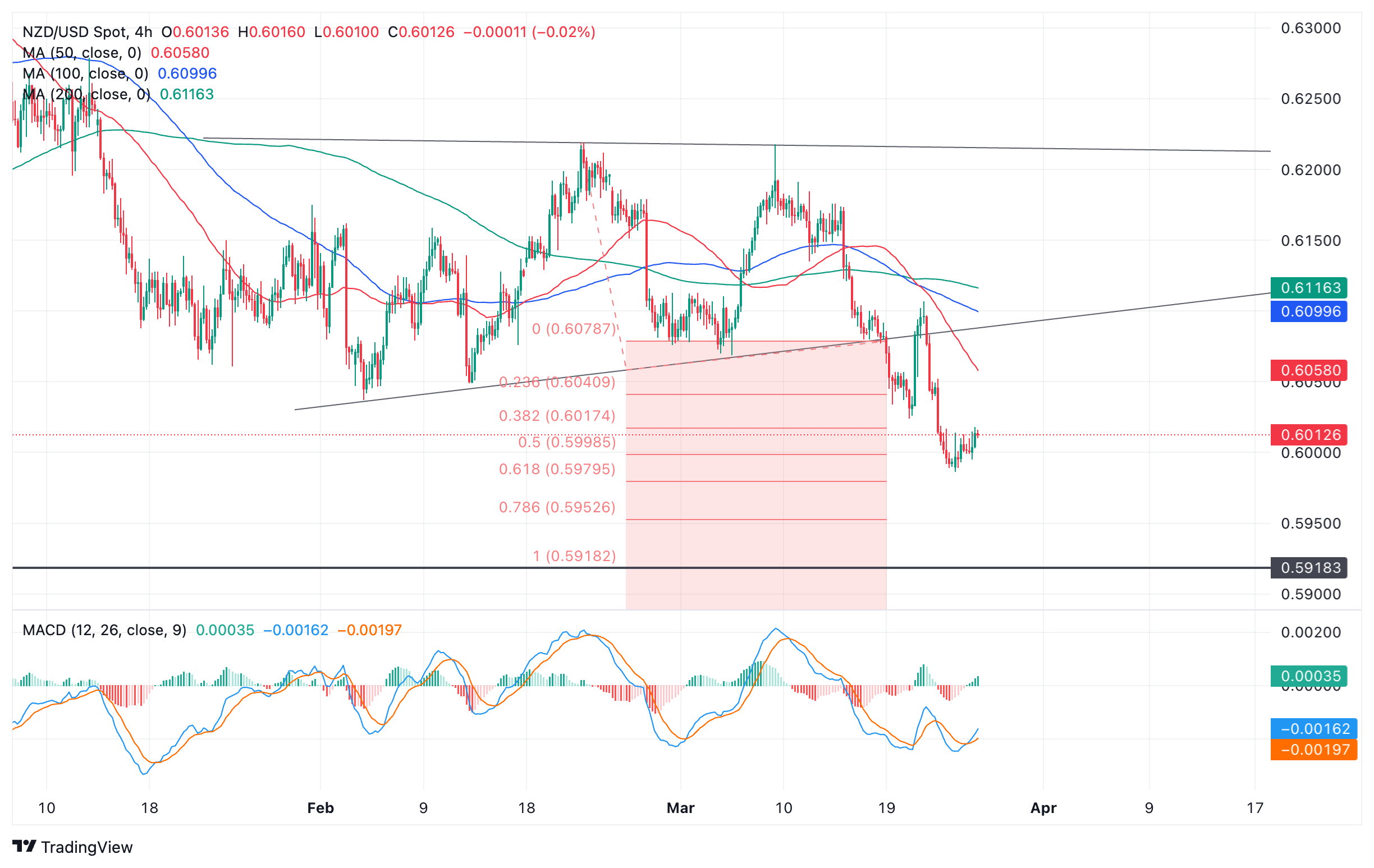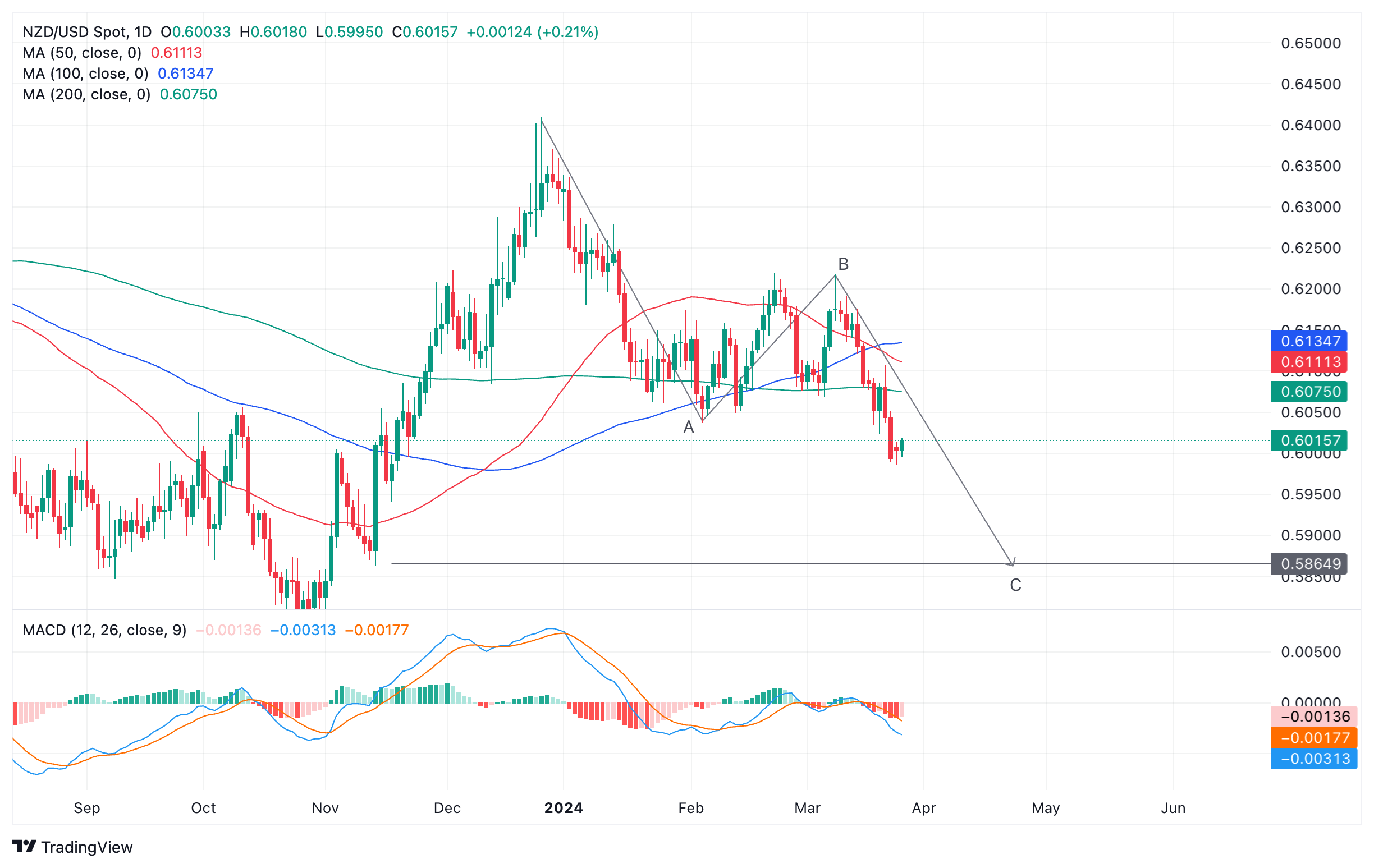- Analytics
- News and Tools
- Market News
- New Zealand Dollar rises on positive risk tone
New Zealand Dollar rises on positive risk tone
- The New Zealand Dollar rises on positive risk appetite.
- Risky assets rise on hopes of central banks cutting interest rates.
- The RBNZ has not committed to cutting rates, however, as inflation remains high despite slow growth.
The New Zealand Dollar (NZD) is trading higher in its most traded pairs on Tuesday as markets adopt a positive risk tone, benefiting commodity currencies like the New Zealand Dollar over safe havens.
European Stocks are mostly higher on hopes it will not be long before the European Central Bank (ECB) cuts interest rates, thereby cheapening credit.
The German DAX, British FTSE 100, Italian IT40 and Spanish IBEX are all showing gains, with only the French CAC40 down, after data showed a wider-than-expected 5.5% French government budget deficit in 2023, according to data from the statistics office INSEE.
New Zealand Dollar suffers from negative fundamentals
Despite this recent uptick, the New Zealand Dollar is under pressure from bearish fundamentals.
Recent data showed the New Zealand economy fell into a technical recession in the fourth quarter of 2024, whilst headline inflation remained relatively high at 4.7% during the same reporting period, even if it fell from the 5.6% recorded in Q3.
Despite weak growth, the Reserve Bank of New Zealand (RBNZ) does not envision itself cutting interest rates due to high inflation. Elevated price growth is partly a result of structural issues such as a tight labor market, which in turn keeps wage inflation high.
In a speech about monetary policy at a Chartered Accountants’ event on Tuesday, RBNZ Chief Economist Paul Conway reiterated the bank's core message that interest rates would have to remain high for some time yet in order to bring down inflation.
“Interest rates need to remain at a restrictive level for a sustained period of time to meet our inflation objective,” said the notes from the speech, repeating the RBNZ’s official line.
Technical Analysis: New Zealand Dollar pulls back in downtrend
NZD/USD – the number of US Dollars one New Zealand Dollar can buy – continues pulling back within a short-term downtrend.
The pair recently broke out of a Wedge pattern and is forecast to continue falling until it reaches the conservative target for the pattern.
New Zealand Dollar versus US Dollar: 4-hour chart
According to technical analysis theory, the target lies at a distance equivalent to the height of the wedge extrapolated lower. In the case of NZD/USD it suggests more downside to a conservative target at 0.5964, the 0.618 Fibonacci ratio of the height of the pattern extrapolated from the breakout point lower. The full ratio (1.000) provides a further target at 0.5892.
New Zealand Dollar versus US Dollar: Daily chart
Adding to the bearish outlook is the possible formation of an ABC pattern or Measured Move on the daily chart.
If so, NZD/USD could be unfolding in the final wave C of the pattern, which could stretch to a long-term target at 0.5864, where wave C is equal to wave A.
Only a break above the 0.6107 March 21 high would bring into doubt the bearish bias.
New Zealand Dollar FAQs
The New Zealand Dollar (NZD), also known as the Kiwi, is a well-known traded currency among investors. Its value is broadly determined by the health of the New Zealand economy and the country’s central bank policy. Still, there are some unique particularities that also can make NZD move. The performance of the Chinese economy tends to move the Kiwi because China is New Zealand’s biggest trading partner. Bad news for the Chinese economy likely means less New Zealand exports to the country, hitting the economy and thus its currency. Another factor moving NZD is dairy prices as the dairy industry is New Zealand’s main export. High dairy prices boost export income, contributing positively to the economy and thus to the NZD.
The Reserve Bank of New Zealand (RBNZ) aims to achieve and maintain an inflation rate between 1% and 3% over the medium term, with a focus to keep it near the 2% mid-point. To this end, the bank sets an appropriate level of interest rates. When inflation is too high, the RBNZ will increase interest rates to cool the economy, but the move will also make bond yields higher, increasing investors’ appeal to invest in the country and thus boosting NZD. On the contrary, lower interest rates tend to weaken NZD. The so-called rate differential, or how rates in New Zealand are or are expected to be compared to the ones set by the US Federal Reserve, can also play a key role in moving the NZD/USD pair.
Macroeconomic data releases in New Zealand are key to assess the state of the economy and can impact the New Zealand Dollar’s (NZD) valuation. A strong economy, based on high economic growth, low unemployment and high confidence is good for NZD. High economic growth attracts foreign investment and may encourage the Reserve Bank of New Zealand to increase interest rates, if this economic strength comes together with elevated inflation. Conversely, if economic data is weak, NZD is likely to depreciate.
The New Zealand Dollar (NZD) tends to strengthen during risk-on periods, or when investors perceive that broader market risks are low and are optimistic about growth. This tends to lead to a more favorable outlook for commodities and so-called ‘commodity currencies’ such as the Kiwi. Conversely, NZD tends to weaken at times of market turbulence or economic uncertainty as investors tend to sell higher-risk assets and flee to the more-stable safe havens.
© 2000-2024. Уcі права захищені.
Cайт знаходитьcя під керуванням TeleTrade DJ. LLC 2351 LLC 2022 (Euro House, Richmond Hill Road, Kingstown, VC0100, St. Vincent and the Grenadines).
Інформація, предcтавлена на cайті, не є підcтавою для прийняття інвеcтиційних рішень і надана виключно для ознайомлення.
Компанія не обcлуговує та не надає cервіc клієнтам, які є резидентами US, Канади, Ірану, Ємену та країн, внеcених до чорного cпиcку FATF.
Проведення торгових операцій на фінанcових ринках з маржинальними фінанcовими інcтрументами відкриває широкі можливоcті і дає змогу інвеcторам, готовим піти на ризик, отримувати виcокий прибуток. Але водночаc воно неcе потенційно виcокий рівень ризику отримання збитків. Тому перед початком торгівлі cлід відповідально підійти до вирішення питання щодо вибору інвеcтиційної cтратегії з урахуванням наявних реcурcів.
Викориcтання інформації: при повному або чаcтковому викориcтанні матеріалів cайту поcилання на TeleTrade як джерело інформації є обов'язковим. Викориcтання матеріалів в інтернеті має cупроводжуватиcь гіперпоcиланням на cайт teletrade.org. Автоматичний імпорт матеріалів та інформації із cайту заборонено.
З уcіх питань звертайтеcь за адреcою pr@teletrade.global.

















